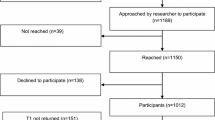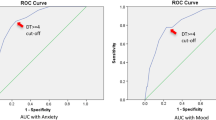Abstract
Purpose
The purpose of this study was to explore the ability of Distress Thermometer (DT) scores to discern important differences in quality of life scores among women with breast cancer.
Methods
The National Comprehensive Cancer Network’s DT, the Functional Assessment of Cancer Therapy—Breast (FACT–B), and a demographic questionnaire were completed by 111 women recently diagnosed with breast cancer.
Results
Patients considered moderately to severely distressed (score ≥ 4 on DT) scored significantly lower on FACT–B QOL scales and subscales when compared to those in the group scoring 3 or below. For those scales for which minimally important differences (MIDs) have been established, differences between the two groups were 2–3 and a half times the established MID.
Conclusions
Moderately to severely distressed patients have significantly lower QOL than those with expected or mild distress. The DT provides a quick and easy screening tool to alert the healthcare team to clinically relevant alterations in patients’ QOL.
Similar content being viewed by others
References
World Health Organization. (2011). Breast cancer: Prevention and control. Retrieved May 10th, 2011, from http://www.who.int/cancer/detection/breastcancer/en/.
Howlader, N., Noone, A. M., Krapcho, M., Neyman, N., Aminou, R.,& Waldron, W. et al. (2011). SEER stat fact sheets: Breast. Retrieved May 10th, 2011, from http://www.seer.cancer.gov/statfacts/html/breast.html.
National Comprehensive Cancer Network. (2010). NCCN clinical practice guidelines in oncology: Distress management. (Vol. v.1.2010). Jenkintown, PA: NCCN.
Madden, J. (2006). The problem of distress in patients with cancer: More effective assessment. Clinical Journal of Oncology Nursing, 10(5), 615–619.
Fox, S. W., Lyon, D., & Farace, E. (2007). Symptom clusters in patients with high-grade glioma. Journal of Nursing Scholarship, 39(1), 61–67.
Pelletier, G., Verhoef, M. J., Khatri, N., & Hagen, N. (2002). Quality of life in brain tumor patients: The relative contributions of depression, fatigue, emotional distress, and existential issues. Journal of Neuro-oncology, 57(1), 41–49.
Manning Walsh, J. K. (2005). Social support as a mediator between symptom distress and quality of life in women with breast cancer. Journal of Obstetric, Gynecologic, and Neonatal Nursing, 34(4), 482–493.
Carlson, L. E., & Bultz, B. D. (2003). Cancer distress screening: Needs, models, and methods. Journal of Psychosomatic Research, 55(5), 403–409.
Cella, D. F., & Cherin, E. A. (1988). Quality of life during and after cancer treatment. Comprehensive Therapy, 14(5), 69–75.
Institute of Medicine, National Research Council. (2005). From cancer patient to cancer survivor: Lost in transition. Washington, D.C.: The National Academies Press.
Ferrell, B. R., Grant, M. M., Funk, B., Otis-Green, S., & Garcia, N. (1997). Quality of life in breast cancer survivors as identified by focus groups. Psycho-Oncology, 6(1), 13–23.
Juarez, G., Ferrell, B. R., Uman, G., Podnos, Y., & Wagman, L. (2008). Distress and quality of life concerns of family caregivers of patients undergoing palliative surgery. Cancer Nursing, 31(1), 2–10.
Institute of Medicine [IOM]. (2008). Cancer care for the whole patient: Meeting psychosocial health needs. Washington, D.C.: The National Academies Press.
Dabrowski, M., Boucher, K., Ward, J. H., Lovell, M. M., Sandre, A., Bloch, J., et al. (2007). Clinical experience with the NCCN distress thermometer in breast cancer patients. Journal of the National Comprehensive Cancer Network, 5(1), 104–111.
Carlson, L. E., Angen, M., Cullum, J., Goodey, E., Koopmans, J., Lamont, L., et al. (2004). High levels of untreated distress and fatigue in cancer patients. British Journal of Cancer, 90(12), 2297–2304.
Fallowfield, L., Ratcliffe, D., Jenkins, V., & Saul, J. (2001). Psychiatric morbidity and its recognition by doctors in patients with cancer. British Journal of Cancer, 84(8), 1011–1015.
Graves, K. D., Arnold, S. M., Love, C. L., Kirsh, K. L., Moore, P. G., & Passik, S. D. (2007). Distress screening in a multidisciplinary lung cancer clinic: Prevalence and predictors of clinically significant distress. Lung Cancer, 55(2), 215–224.
Keir, S. T., Calhoun-Eagan, R. D., Swartz, J. J., Saleh, O. A., & Friedman, H. S. (2008). Screening for distress in patients with brain cancer using the NCCN’s rapid screening measure. Psycho-Oncology, 17(6), 621–625.
Sellick, S. M., & Edwardson, A. D. (2007). Screening new cancer patients for psychological distress using the Hospital Anxiety and Depression Scale. Psycho-Oncology, 16(6), 534–542.
Zabora, J., Brintzenhofeszoc, K., Curbow, B., Hooker, C., & Piantadosi, S. (2001). The prevalence of psychological distress by cancer site. Psycho-Oncology, 10(1), 19–28.
Hegel, M. T., Moore, C. P., Collins, E. D., Kearing, S., Gillock, K. L., Riggs, R. L., et al. (2006). Distress, psychiatric syndromes, and impairment of function in women with newly diagnosed breast cancer. Cancer, 107(12), 2924–2931.
Bultz, B. D., & Holland, J. C. (2006). Emotional distress in patients with cancer: The sixth vital sign. Community Oncology, 3(5), 311–314.
Bultz, B., & Carlson, L. (2006). Emotional distress: The sixth vital sign—Future directions in cancer care. Psycho-Oncol, 15, 93–95.
Shapiro, S., Lopez, A., Schwartz, G., Bootzin, R., Figueredo, A., Braden, C., et al. (2001). Quality of life and breast cancer: Relationship to psychosocial variables. Journal of Clinical Psychology, 57(4), 501–519.
Jacobsen, P. B., Donovan, K. A., Trask, P. C., Fleishman, S. B., Zabora, J., Baker, F., et al. (2005). Screening for psychologic distress in ambulatory cancer patients: A multicenter evaluation of the Distress Thermometer. Cancer, 103(7), 1494–1502.
Kvale, E., Murthy, R., Taylor, R., Lee, J., & Nabors, L. (2009). Distress and quality of life in primary high-grade brain tumor patients. Supportive Care in Cancer, 17(7), 793–799.
National Comprehensive Cancer Network. (2003). Distress management practice guidelines. Journal of the National Comprehensive Cancer Network, 1, 344–374.
Cella, D. F. (1997). Manual of the Functional Assessment of Chronic Illness Therapy (FACIT Scales) (Version 4 ed.). Evanston, IL: Evanston Northwestern Healthcare.
Cohen, M., Hoffman, R. G., Cromwell, C., Schmeidler, J., Ebrahim, F., Carrera, G., et al. (2002). The prevalence of distress in persons with human immunodeficiency virus infection. Psychosomatics, 43(1), 10–15.
Roth, A., Kornblith, A. B., Batel-Copel, L., Peabody, E., Scher, H. I., & Holland, J. C. (1998). Rapid screening for psychologic distress in men with prostate carcinoma: A pilot study. Cancer, 82(10), 1904–1908.
Trask, P., Paterson, A., Riba, M., Brines, B., Griffith, K., Parker, P., et al. (2002). Assessment of psychological distress in prospective bone marrow transplant patients. Bone Marrow Transpl, 29, 917–925.
Ransom, S., Jacobsen, P. B., & Booth-Jones, M. (2006). Validation of the distress thermometer with bone marrow transplant patients. Psycho-Oncology, 15(7), 604–612.
Mitchell, A. J. (2007). Pooled results from 38 analyses of the accuracy of distress thermometer and other ultra-short methods of detecting cancer-related mood disorders. Journal of Clinical Oncology, 25(29), 4670–4681.
Hoffman, B. M., Zevon, M. A., D’Arrigo, M. C., & Cecchini, T. B. (2004). Screening for distress in cancer patietns: The NCCN rapid-screening measure. Psycho-Oncology, 13, 792–799.
Cella, D. F., Tulsky, D. S., Gray, G., Sarafian, B., Linn, E., Bonomi, A., et al. (1993). The functional assessment of cancer therapy scale: Development and validation of the general measure. Journal of Clinical Oncology, 11(3), 570–579.
Eton, D. T., Cella, D., Yost, K. J., Yount, S. E., Peterman, A. H., Neuberg, D. S., et al. (2004). A combination of distribution-and anchor-based approaches determined minimally important differences (MIDs) for four endpoints in a breast cancer scale. Journal of Clinical Epidemiology, 57, 898–910.
Brucker, P., Yost, K., Cashy, J., Webster, K., & Cella, D. F. (2005). General population and cancer patient norms for the Functional Assessment of Cancer Therapy-General (FACT-G). Evaluation And The Health Professions, 28(2), 192–211.
Butt, Z., Wagner, L. I., Beaumont, J. L., Paice, J. A., Peterman, A. H., Shevrin, D., et al. (2008). Use of a single-item screening tool to detect clinically significant fatigue, pain, distress, and anorexia in ambulatory cancer practice. Journal of Pain and Symptom Management, 35(1), 20–30.
Mitchell, A. J., Kaar, S., Coggan, C., Herdman, J., Mitchell, A. J., Kaar, S., et al. (2008). Acceptability of common screening methods used to detect distress and related mood disorders-preferences of cancer specialists and non-specialists. Psycho-Oncology, 17(3), 226–236.
Vodermaier, A., Linden, W., & Siu, C. (2009). Screening for emotional distress in cancer patients: A systematic review of assessment instruments. Journal of the National Cancer Institute, 101(21), 1464–1488.
Akizuki, N., Yamawaki, S., Akechi, T., Nakano, T., & Uchitomi, Y. (2005). Development of an impact thermometer for use in combination with the distress thermometer as a brief screening tool for adjustment disorders and/or major depression in cancer patients. Journal of Pain and Symptom Management, 29(1), 91–99.
Bauwens, S., Baillon, C., Distelmans, W., & Theuns, P. (2009). The ‘Distress Barometer’: Validation of method of combining the Distress Thermometer with a rated complaint scale. Psycho-Oncology, 18(5), 534–542.
Quinten, C., Coens, C., Mauer, M., Comte, S., Sprangers, M., Cleeland, C., et al. (2009). Baseline quality of life as a prognostic indicator of survival: A meta-analysis of individual patient data from EORTC clinical trials. The Lancet, 10, 865–871.
Goodwin, P. J., Black, J. T., Bordeleau, L. J., & Ganz, P. A. (2003). Health-related quality-of-life measurement in randomized clinical trials in breast cancer–taking stock. Journal of the National Cancer Institute, 95(4), 263–281.
Calman, K. C. (1984). Quality of life in cancer patients–an hypothesis. Journal of Medical Ethics, 10(3), 124–127.
Horner, M. J., Reis, L. A. G., Krapcho, M., Neyman, N., Aminou, R., & Howlader, N. et al. (Eds.). (2009). SEER cancer statistics review, 1975–2006 National Cancer Institute. Retrieved June 30, 2009, from http://seer.cancer.gov/csr/1975_2006/.
Meyerowitz, B. E., & Oh, S. (2009). Psychosocial response to cancer diagnosis and treatment. In S. M. Miller, D. J. Bowen, R. T. Croyle, & J. H. Rowland (Eds.), Handbook of cancer control and behavioral science: A resource for researchers, practitioners, and policymakers (pp. 361–377). Washington D.C.: American Psychological Association.
Baucom, D., Porter, L., Kirby, J., Gremore, T., & Keefe, F. (2005/2006). Psychosocial issues confronting young women with breast cancer. Breast Disease, 23(1), 103–113.
Allen, S., Shah, A., Nezu, A., Nezu, C., Ciambrone, D., Hogan, J., et al. (2002). A problem solving approach to stress reduction among younger women with breast carcinoma: A randomized controlled trial. Cancer, 94(12), 3089–3100.
Avis, N., Crawford, S., & Manuel, J. (2005). Quality of life among younger women with breast cancer. Journal of Clinical Oncology, 23(15), 3322–3330.
Wong-Kim, E., & Bloom, J. (2005). Depression experienced by young women newly diagnosed with breast cancer. Psycho-Oncology, 14, 564–573.
Parker, P. A., Baile, W. F., De Moor, C., & Cohen, L. (2003). Psychosocial and demographic predictors of quality of life in a large sample of cancer patients. Psycho Oncology, 12(2), 183–193.
Cella, D. F. (1994). Quality of life: Concepts and definition. Journal of Pain and Symptom Management, 9(3), 186–192.
Overcash, J., Extermann, M., Parr, J., Perry, J., & Balducci, L. (2001). Validity and reliability of the FACT-G scale for use in the older person with cancer. American Journal of Clinical Oncology, 24(6), 591–596
Brady, M. J., Cella, D. F., Mo, F., Banomi, A. E., Tulsky, D. S., Lloyd, S. R., Deasy, S., Cobleigh, M., & Shiomoto, G. (1997). Reliability and validity of the Functional Assessment of Cancer Therapy-Breast quality-of-life instrument. Journal of Clinical Oncology, 15(3), 974–986.
Author information
Authors and Affiliations
Corresponding author
Rights and permissions
About this article
Cite this article
Head, B.A., Schapmire, T.J., Keeney, C.E. et al. Use of the Distress Thermometer to discern clinically relevant quality of life differences in women with breast cancer. Qual Life Res 21, 215–223 (2012). https://doi.org/10.1007/s11136-011-9934-3
Accepted:
Published:
Issue Date:
DOI: https://doi.org/10.1007/s11136-011-9934-3




